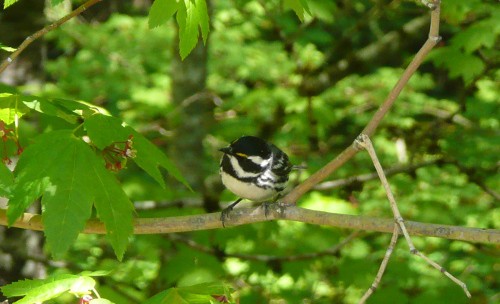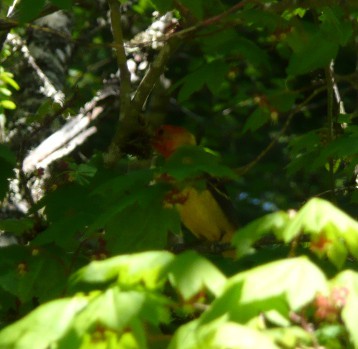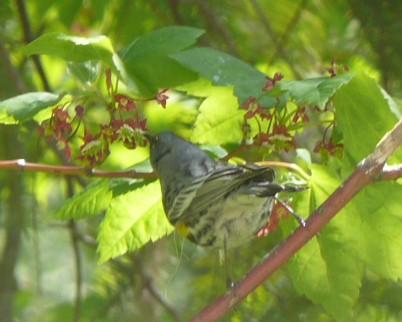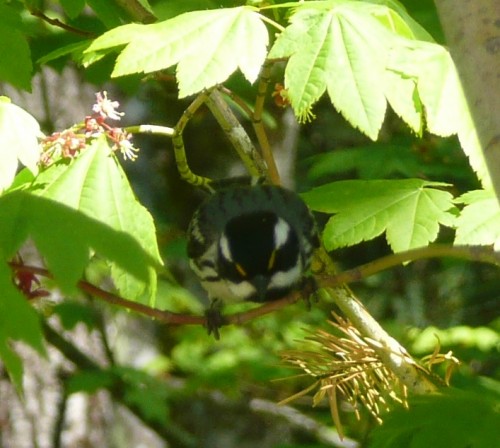New Forest Voices

“Cheerio~ Cheeriup~ Cheerio~ Cheeriup~” The American Robin’s song is a loud, optimistic voice of spring. However, at times here in the mountains it is difficult to hear the Robin because of the sheer number of springtime songsters! The colorful Varied Thrush sounds like someone unanswered phone in the woods. The tenacious Rufous Hummingbird buzzes, bugles and chirps. There are other, more difficult to identify, voices in our spring chorus.
First up was a mysterious voice I could hear far off in the woods but I could never catch a glimpse of. It’s three-syllable buzzing-chirps reminded me vaguely of a familiar voice from back east: the Red-eyed Vireo’s “Here I am! Over here! In the tree!”. The song was wrong though, and the Red-eyed Vireo isn’t a common resident here. After much listening and looking I discovered it was brightly colored, but very sneaky, Western Tanager! It’s hard to catch a glimpse of this amazing orange and yellow bird high up in the trees, but if you’re patient you can spot them.

Top: A Black-throated Gray Warbler looking for bugs in a Vine Maple. Above: A Western Tanager Hiding behind Vine Maple leaves.
Another early bird of spring was the Yellow-Rumped Warbler. These birds are mostly white, black and slate-gray (almost blue-tinged). However, they do indeed have a yellow rump; they also have yellow sides and a yellow crown! Just as soon as I was getting used to this birds trilling song a whole new army of warblers arrived.

A Yellow-rumped Warbler defying identification, standing in such a way that all of its yellow patches covered.
Warblers, if you are unfamiliar with them, are all small-ish birds with bright colors and buzzy, high-pitched songs. They’re beautiful and confusing. Some birds are kind enough to have songs that you can use clever mnemonics to remember. Like the American Goldfinch’s call of “Po-ta-to chip!”, or the Chickadees’ habit of singing their own name. My favorite birdsong mnemonic is from back in Virginia where the Eastern Towhee would invite you to “DRINK your Tea~!”.
Warblers are not so generous with their songs. The Townsend’s Warbler, which we’ve been hearing here lately says: “… zoo zoo zoo zeee skeea skeea or weezy weezy weezy dzee…” (according to David Sibley’s Field Guide to Birds of Western North America). Compare with our dapper Black-throated Gray Warbler from the top of the page: “zeea zeea zeea ZEEE zaa zoo…”. I appreciate the efforts of field-guide writers but it’s one thing to read a series of weezy weezy weezies and another thing to hear them!
It is, of course, a matter of practice. If you sit and listen to the birds sing long enough you get a feel for their songs. You start to understand the “zeea”s and the “weezy dzee”s. Just like listening to a familiar tune or recognizing the voice of an old friend. Learning the songs of birds that I am unfamiliar with makes me happy and now I can wake up each morning to the voices of new friends.
Coming up on June 5th through 7th, we’re hosing a Spring Birding Weekend here at the Learning Center. There will be lots of exciting birding trips with expert-birders Libby Mills, Jim Alt, and our lead naturalist, Adam Russell. We’ll even have a presentation by Paul Bannick of his stunning bird photographs.
Oh, and I’ll be there, too. Probably still following warblers around trying to figure out which ones are singing which songs!



This is super cool Kelly!!! Makes me want to get out and really listen to birds right now!
Great photos!